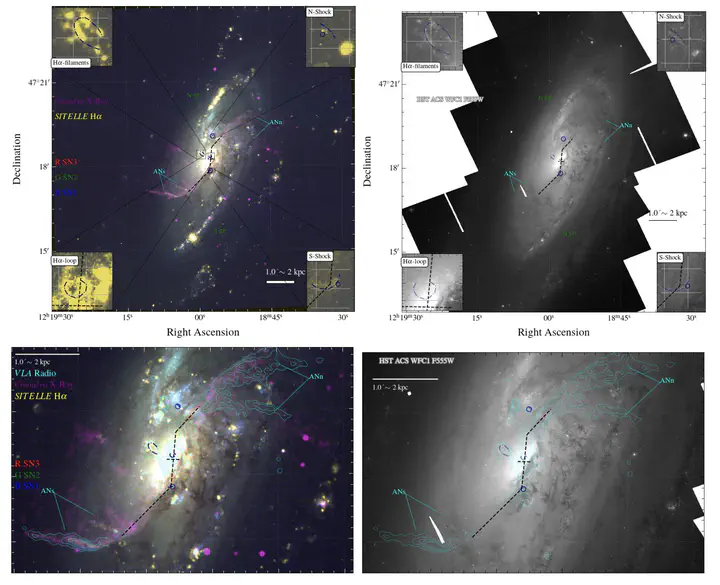Ionized gas in NGC 4258: Exploring the AGN - Star formation connection
David Fernández-Arenas, Laurie Rousseau-Nepton, Carmelle Robert, Laurent Drissen, R. Pierre Martin, Philippe Amram, Benoît Epinat, Salvador Duarte Puertas, Ray Garner, Gabriel Savard, Sébastien Vicens-Mouret, Étienne Massé
July, 2025Abstract
NGC 4258 is a prime target for studying feedback in Low-Luminosity Active Galactic Nuclei (LLAGNs) due to its proximity and comprehensive multi-wavelength coverage. Using new Integral Field Spectroscopy (IFS) data from SITELLE at the Canada-France-Hawaii Telescope, we analysed the galaxy’s nebular emission lines. Our study focused on spatially resolved line ratios and Baldwin-Phillips-Terlevich diagrams, revealing that the ‘anomalous spiral arms’ exhibit intense interactions between the jet and interstellar medium (ISM) extending up to 6 kpc with velocity dispersions peak at 200-250 km/s in these regions, contrasting with star-forming areas showing lower values around of 30-50 km/s. Analysis of covering fractions indicates heightened AGN ionization cones aligns with the radio jet, alongside evidence of shock quenching observed in the lower ‘anomalous arc’. Conversely, jet-induced compression may stimulate star formation in other areas. We derived a galaxy-wide star formation rate of ~3 M yr, decreasing to 0.3 M yr within the central 3.4 kpc. SITELLE’s broad field coverage elucidates the galaxy’s structural details, confirming that low-power jets significantly influence the host galaxy across parsec and kpc scales. The velocity dispersion map reveals asymmetric or double-peaked emission lines, traicing jet-disk interactions likely responsible for the formation of anomalous arm features. Small-scale ionizing clusters were detected in regions with disrupted gas flows, possibly formed through tidal interactions or shock compression. NGC 4258 thus presents a compelling case for studying LLAGN-driven feedback, illustrating how optical IFS combined with multi-wavelength data clarifies the impact of outflows and shocks on nearby spiral galaxies, providing insights into how these processes shape star formation and ISM conditions.
Publication
In The Monthly Notices of the Royal Astronomical Society

TAMU Astronomy Postdoctoral Researcher
I’m a scientist, Star Wars fan, and amateur photographer raised in Georgia. My research interests include galaxy evolution, star formation, satellite galaxies, and nebular diagnostics.
 Left: The SITELLE view of NGC 4258 with particular morphological features marked. Right: the HST view of NGC 4258 at the same scales.
Left: The SITELLE view of NGC 4258 with particular morphological features marked. Right: the HST view of NGC 4258 at the same scales.